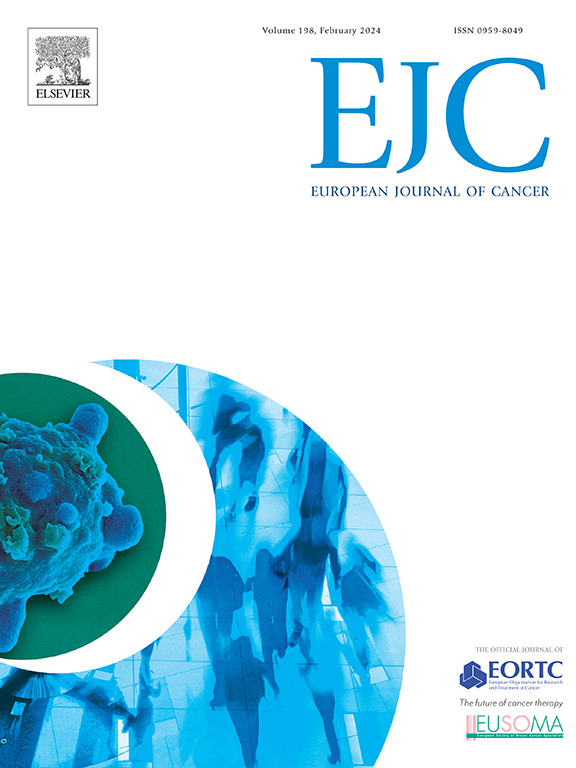所有错配修复缺陷的子宫内膜癌都是一样的吗?一个大型的,回顾性的,三级中心的经验
IF 7.6
1区 医学
Q1 ONCOLOGY
引用次数: 0
摘要
背景:三分之一的子宫内膜癌(ECs)表现为错配修复缺陷(MMRd)。其中,70% %是由MLH1启动子的体细胞超甲基化引起的;其余病例由Lynch综合征或MMR基因双体失活确定。虽然与良好的中期预后相关,但在MMRd ECs中,治疗反应和生存存在异质性。我们的目标是通过免疫组织化学(IHC)和MLH1甲基化分析来研究三种MMRd EC亚型在病理侵袭性和无事件生存(EFS)方面的差异。方法回顾性分析接受手术分期的EC患者。对所有患者进行免疫组化分析以评估MMR和p53状态。在ihc -阴性MLH1的MMRd患者中进行甲基化分析。MMRd人群分为:1)mlh1 -高甲基化(MLH1-HyMet);2) MLH1-unmethylated (MLH1-UnMet);3) ihc阴性MSH2和/或单独MSH6或PMS2(非mlh1)。结果在接受手术分期和免疫组化评估的1171例患者中,362例(30.9 %)被分类为MMRd并纳入分析。其中,59.7 % (n = 216)MLH1-HyMet, 11 % (n = 40)MLH1-UnMet,和29.3 % (n = 106)non-MLH1。与MLH1-UnMet和非mlh1相比,MLH1-HyMet与年龄较大、BMI较高、肿瘤大小较大、肌层浸润较深、淋巴血管间隙浸润较大、早期和低危性疾病发生率较低相关。在比较MMRd亚型时,即使在调整分期和肿瘤组织学后,EFS也是相似的。然而,可以观察到MLH1-HyMet倾向于较差的预后,特别是在晚期/转移性环境中。结论与其他MMRd亚组相比,smlh1高甲基化的MMRd ECs表现出更具侵袭性的临床病理特征。然而,尽管在高甲基化亚群中观察到较差的EFS趋势,特别是在晚期环境中,但在MMRd亚型中未检测到预后的显着差异。本文章由计算机程序翻译,如有差异,请以英文原文为准。
Are all mismatch repair deficient endometrial cancers created equal? A large, retrospective, tertiary center experience
Background
One third of endometrial carcinomas (ECs) presents with mismatch repair deficiency (MMRd). Of these, 70 % are caused by somatic hypermethylation of MLH1 promoter; the remaining cases are determined by Lynch syndrome or double somatic inactivation of MMR genes. Although associated with good-intermediate prognosis, heterogeneity in treatment response and survival has been reported among MMRd ECs. We aim to investigate differences in pathologic aggressiveness and event-free survival (EFS) among three MMRd EC subtypes, classified by immunohistochemistry (IHC) and MLH1 methylation analysis.
Methods
Subjects undergone surgical staging for EC were retrospectively included. IHC analysis was performed in all patients to assess MMR and p53 status. Methylation analysis was performed in MMRd patients with IHC-negative MLH1. The MMRd population was classified into: 1)MLH1-hypermethylated (MLH1-HyMet); 2)MLH1-unmethylated (MLH1-UnMet); 3)IHC-negative MSH2 and/or MSH6 or PMS2 alone (non-MLH1).
Results
Of 1171 patients undergoing surgical staging and IHC assessment, 362 (30.9 %) were classified as MMRd and included in the analysis. Among these, 59.7 % (n = 216) were MLH1-HyMet, 11 % (n = 40) MLH1-UnMet, and 29.3 % (n = 106) non-MLH1. Compared to MLH1-UnMet and non-MLH1, MLH1-HyMet was associated with older age, higher BMI, larger tumor size, deeper myometrial invasion, substantial lymphovascular space invasion, lower frequency of early-stage and low-risk disease. EFS was similar when comparing the MMRd subtypes, even after adjusting for stage and tumor histology. However, a trend of MLH1-HyMet toward poorer prognosis can be observed, particularly in the advanced/metastatic setting.
Conclusions
MLH1-hypermethylated MMRd ECs display more aggressive clinicopathologic features compared to the other MMRd subgroups. However, although a suggestive trend toward poorer EFS was observed in the hypermethylated subset, particularly in the advanced setting, no significant differences in prognosis were detected among the MMRd subtypes.
求助全文
通过发布文献求助,成功后即可免费获取论文全文。
去求助
来源期刊

European Journal of Cancer
医学-肿瘤学
CiteScore
11.50
自引率
4.80%
发文量
953
审稿时长
23 days
期刊介绍:
The European Journal of Cancer (EJC) serves as a comprehensive platform integrating preclinical, digital, translational, and clinical research across the spectrum of cancer. From epidemiology, carcinogenesis, and biology to groundbreaking innovations in cancer treatment and patient care, the journal covers a wide array of topics. We publish original research, reviews, previews, editorial comments, and correspondence, fostering dialogue and advancement in the fight against cancer. Join us in our mission to drive progress and improve outcomes in cancer research and patient care.
 求助内容:
求助内容: 应助结果提醒方式:
应助结果提醒方式:


